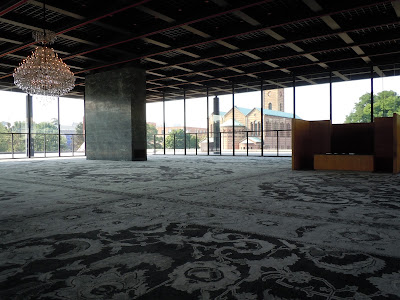In the beginning, there was the Nationalgalerie, the sacred repository of German art, which I wrote about in a previous post. Then came the partition of Berlin, and the Nationalgalerie, along with other great institutions located on Museum Island, was in the Eastern Zone. The Western powers decided there had to be a national gallery on their side, and it should focus on modern art, and had Mies van der Rohe design a stunningly modern building for the new propaganda tour de force. From that point on, there was the Alte Nationalgalerie and the Neue Nationalgalerie, and you don't need much German to tell the difference as we visit the Neue today.
The entry floor, sheathed in glass, contains nothing but a couple of support columns and an attendant to point you toward the down staircase; all the art is housed below ground, partly to protect it from sunlight. When we visited, the entry floor was the site of a temporary installation by Rudolf Stingel, a huge carpet woven with patterns from 19th century Indian rugs to complement the stark architecture and to reference the iconic place of oriental carpets in well-to-do European households. I've seen Stingel's carpets in other venues but this space was spectacular, with nothing to interrupt your view of the goods.
Downstairs, the permanent exhibits provided a chronological view both of German art in the 20th century and of the German society and history reflected in it. I'll have to take more than one post to tell you about this fabulous collection, so I'll start with the earliest parts. In the 20s, for instance, Neue Sachlichkeit (New Objectivity) artists wanted to distance themselves from war and emotions, painting cool and precise pictures of architecture and technology.
Franz Radziwill, Der Hafen II (The Harbor II), 1930
Gustav Wunderwald, Am Wedding (a neighborhood in Berlin), 1927
Georg Schrimpf, Bahnübergang (Railway Crossing), 1932
Oskar Nerlinger, Funkturm und Hochbahn (Radio Tower and Elevated Railway), 1929
In contrast to these cool characters, another school of art seized on politics for its subjects, with scathing views of the social turmoil following the World War. (Today is what we used to call Armistice Day, commemorating the end of that war on the Western Front, at 11 AM on 11/11/18.)
Josef Scharl, Ecce Homo/Der Verstümmelte (Ecce homo / Mutilated Man), 1931
Curt Querner, Agitator, 1931
Conrad Felixmüller, Der Agitator, 1944
Reinhold Rossig, Polizieterror (Police Terror), 1933
George Grosz, Stützen der Gesellschaft (Pillars of Society), 1926
Both my husband and I have always loved Grosz and his savage portrayals of German society between the wars. Seeing so many of these images, both by Grosz and others, was a real punch in the gut. This museum has a powerful impact throughout but nowhere as strong as in these pictures, which presciently anticipate the even greater turmoils ahead (note the swastika on the tie of the guy in front).
Subscribe to:
Post Comments (Atom)
















Kathleen, thank you so much for this informative and powerful post. The art that you shared does impact one very much on a gut level. I can only imagine that the Mies van der Rohe building is an exquisite thing to behold in person. I love seeing art that I am not familiar with. Thanks again for your always thought provoking posts. I look forward to any future posts that might you share of this collection.
ReplyDeleteI just came across your page while doing research on a paper about the Neue Nationalgalerie. There is one point, in which your description is off, which is saying that there are supportive columns inside the NNG. These big, massive looking stone things inside function as cable ducts.
ReplyDeletethis is one example of the great semiotic that has been used in this architecture, you can check it on your own picture, there is a shadow gap between column and roof.
this, and many other decisions in the building, was made to encode certain messages from the architect to the visitor. what he tries to tell us?
write your guesses below ;)